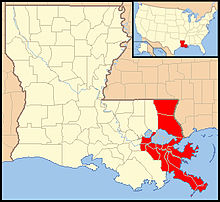As a part of the colonial empires of France and Spain, all settlers of Louisiana were to be Catholic if the were to be recognized as faithful subjects. According to the Code Noir (French law that governed the treatment of slaves) mandated that all slaved by instructed and baptized in the Catholic faith. The slaves must also by freed from work on Sunday and treated humanely.
 |
| https://en.wikipedia.org/wiki/Roman_Catholic_Archdiocese_of_New_Orleans |
This Archdiocese covered the Louisiana Territory from the Gulf of Mexico to the Canadian Border, also including the Florida peninsula and the Gulf coast. Today, three are 57 diocese where the Diocese of Louisiana and the Floridas once was.
The archdiocese consisted of French, Spanish, Irish, Germans, Acadians, Canary Islanders, Native Americans, freed slaves, free people of color, Italians, Hungarians, Cubans, Vietnamese, and Americans. No other city in the territories had adapted that kind of coexistence yet, and today it is still a problem throughout the world.
The Ursulines arrived in Louisiana in 1727 to minister at the French Royal Hospital and teach young girls. During the nineteenth century, religious many religious communities were formed such as: Daughters of Charity, Sisters of Mount Carmel, School Sisters of Notre Dame, Sisters of St. Joseph, Sisters of the Good Shepherd and the Dominicans Sisters.
The French colonists were Catholic and thoroughly enjoyed fine living and clothing. New Orleans developed into a unique French-infused city much later, with a mixture of African American culture, jazz, and blues music in the 20th century. New Orleans is also known for its festivity of Mardi Gras, which in French means "Fat Tuesday". Mardi Gras "celebrates the beginning of Lent, a Catholic observance that serves as the lead-up to Easter". The King cakes also have a small baby inside that represent the baby Jesus.
 |
| Photo by KHatcher |
 |
| Photo by KHatcher |
 |
| Photo by KHatcher. What the Catholic Church looks like now. |
 |
| Photo by KHatcher |
No comments:
Post a Comment